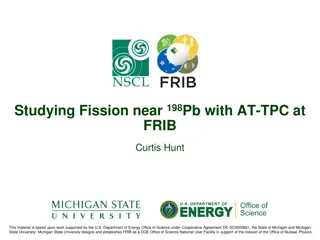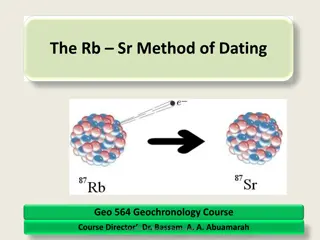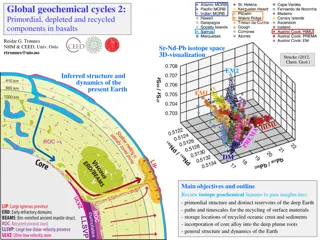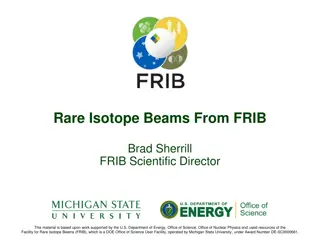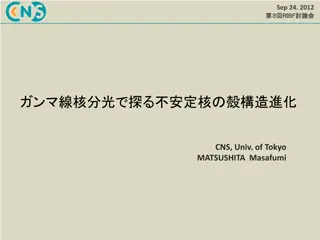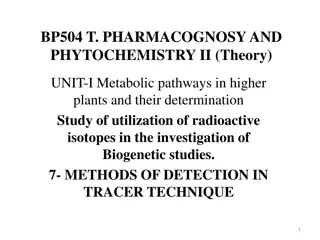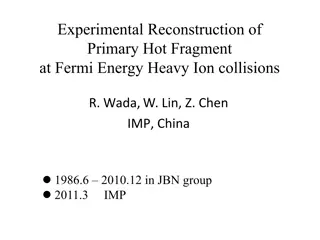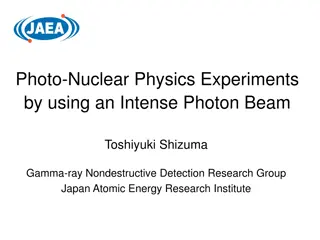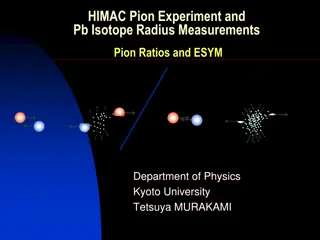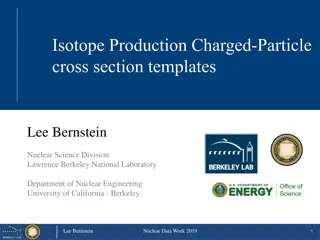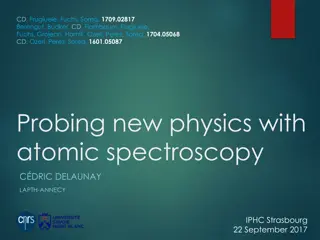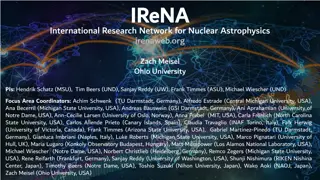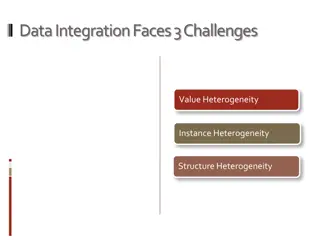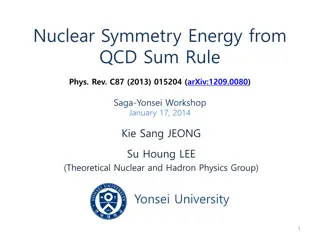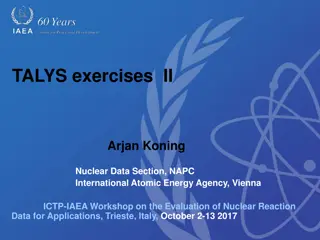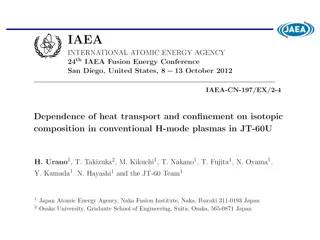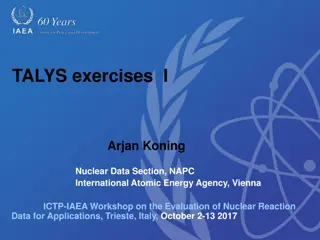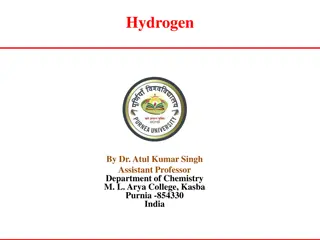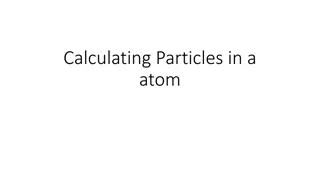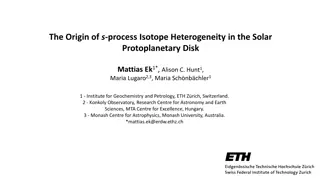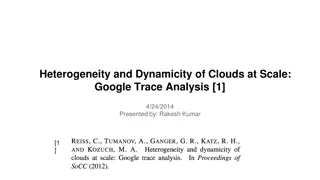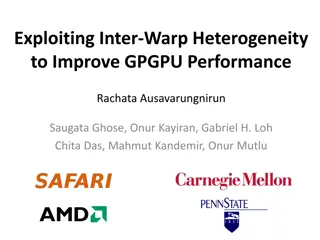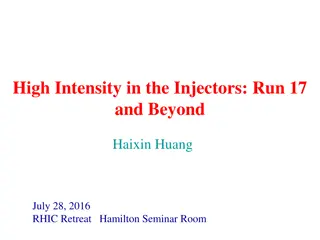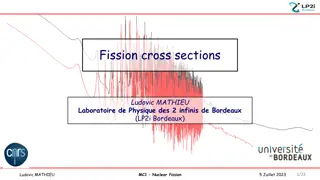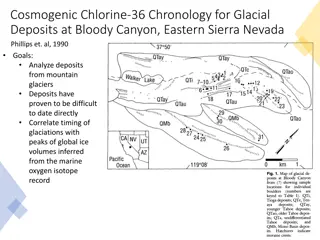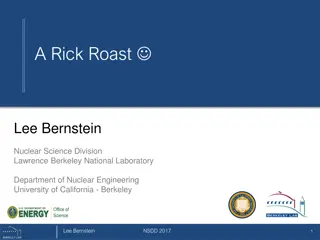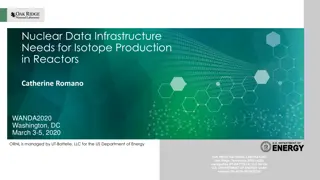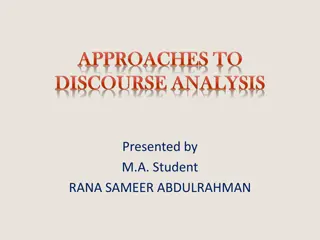Characterising Risk and Biology of Smouldering Myeloma for Early Detection of Symptomatic Myeloma
Understand the risk and biology of smouldering myeloma (SMM) for early detection of symptomatic myeloma. The study will investigate genomic and immune correlates of progression, clonal heterogeneity, and biomarkers using liquid biopsies and T cell phenotype and functionality in SMM.
4 views • 15 slides
Exploring Fission Near 198Pb with AT-TPC at FRIB: Insights from Curtis Hunt
Delve into the intriguing world of fission studies near 198Pb using the AT-TPC at FRIB. Supported by the DOE Office of Science, this research probes nuclear structure, fission properties, and fusion-fission reactions. By employing innovative techniques like the Heavy Isotope Tagger and active target
1 views • 39 slides
Overview of Particle Accelerators and Isotope Production Methods
Explore various types of particle accelerators such as Direct Voltage Accelerators, Van de Graaff Generators, Tandem Van de Graaff Accelerators, and Linear Accelerators used in generating particles for isotope production, research, and industrial applications. These technologies play a crucial role
3 views • 22 slides
Understanding the Rb-Sr Method of Dating in Geochemistry
Explore the principles of the Rb-Sr dating method in geochemistry, focusing on radioactive decay of Rubidium and Strontium isotopes in geological materials. Learn about isotope data presentation, application in dating geological processes, and the significance of Rb and Sr in the periodic table.
3 views • 62 slides
Understanding the Paradox of Plankton and Biodiversity Correlates
The paradox of plankton challenges the theory that the number of species should match available resources, as seen in diverse plankton ecosystems. Explanations include resource partitioning, temporal and spatial heterogeneity, predation, adaptation to disturbance, and evolutionary processes. Biodive
3 views • 40 slides
Insights into Earth's Geochemical Cycles and Isotopic Evolution
Explore the primordial, depleted, and recycled components in basalts to understand deep Earth reservoirs, recycling paths, and core-mantle dynamics using isotope geochemistry. Learn about radioactive decay systems, mantle array evolution, and U-Th-Pb systematics in planetary differentiation.
6 views • 30 slides
Rare Isotope Beams from FRIB - Facility Overview and Operations
FRIB (Facility for Rare Isotope Beams) is supported by the U.S. Department of Energy and Michigan State University. It utilizes advanced techniques for rare isotope beam formation, offering insights into nuclear physics. The facility operates with high beam power, serving various scientific experime
0 views • 15 slides
Advances in Nuclear Physics Research at RIKEN's RIBF Facility
Cutting-edge research at RIKEN's Radioactive Isotope Beam Factory (RIBF) in collaboration with the University of Tokyo, focusing on gamma-ray spectroscopy setups, in-beam experiments, and detector arrays like DALI2. The experiments involve studying reaction channels, Doppler shift effects, and explo
0 views • 20 slides
Methods of Detection in Tracer Technique for Biogenetic Studies
Explore the methods utilized in tracer techniques for investigating biogenetic pathways in plants. Learn about competitive feeding, precursor-product sequence method, sequential analysis, and isotope incorporation. These methods involve labeling experiments to trace metabolic pathways and understand
0 views • 17 slides
Experimental Reconstruction of Primary Hot Fragment in Heavy Ion Collisions
Investigation into primary hot fragment reconstruction at Fermi energy heavy ion collisions, utilizing experimental data and simulations to reconstruct excitation energy, mass, and charge of primary fragments. Techniques like kinematical focusing and isotope identification were employed, with a focu
0 views • 36 slides
Advanced Photon-Beam Experiments in Nuclear Physics Research
Explore cutting-edge experiments in nuclear physics using intense photon beams, nondestructive isotope detection, laser Compton scattering rays, and photon beams for fundamental collective motion studies. Learn about nuclear resonance fluorescence, dipole excitation strength distribution, and detail
0 views • 12 slides
Nuclear Physics Research Highlights: Neutron Stars, Nuclear EOS, and Pb Isotope Studies
Explore cutting-edge research in nuclear physics, including experiments on pion ratios and Pb isotope radius measurements, neutron star observations, neutron density distributions of Pb isotopes, and polarized proton beams at Osaka University. Learn about the analysis of realistic point proton densi
0 views • 26 slides
Isotope Production Charged Particle Cross Section Techniques
The process of measuring angle-integrated charged-particle cross sections using the stacked target technique is discussed. The method involves the use of monitor foils, degraders, and a beam foil of interest to determine energy and flux. Uncertainties in the measurements and the correction for flux
1 views • 3 slides
Exploring Physics Beyond the Standard Model through Atomic Spectroscopy
Unlocking the mysteries of physics beyond the Standard Model using atomic spectroscopy techniques. Delving into the shortcomings of the Standard Model and the quest for new physics through precision measurements of atomic forces and isotope shifts in heavy atoms. Highlighting the importance of the p
0 views • 47 slides
IReNA: International Research Network for Nuclear Astrophysics
IReNA is an international network of networks focused on nuclear astrophysics, connecting researchers from various countries and institutions to enhance collaboration. Networks include Rare Isotope Accelerators, Gravitational Waves, Neutrino Physics, and more, aiming to advance research in the field
0 views • 11 slides
Machine Learning for Molten Salt Reactor Safeguards
Molten salt reactors face challenges in material accounting due to liquid fuel which precludes traditional safeguards. This project proposes a two-step approach involving the development of measurement signatures created by material diversion, and a machine learning model to distinguish normal react
1 views • 18 slides
Challenges in Data Integration: Heterogeneity and Solutions
Data integration faces challenges such as value heterogeneity, instance heterogeneity, and structure heterogeneity. Existing solutions assume independence of data sources and utilize methods like data fusion, truth discovery, string matching, object matching, schema matching, and model management. T
0 views • 5 slides
Magnetic Field Suppression and Cavity Frequency Control in SRF Development at FRIB
This material discusses the techniques used at the Facility for Rare Isotope Beams (FRIB) to suppress magnetic fields and control cavity frequencies. It covers topics such as remnant field suppression, solenoid package design, validation tests, and magnetic shield material validation for the FRIB cr
0 views • 14 slides
Exploring Nuclear Symmetry Energy with QCD Sum Rule
This study delves into the concept of nuclear symmetry energy through the lens of QCD Sum Rule, discussing its implications in Rare Isotope Accelerator Plan and nucleon-nucleus scattering. Utilizing mean field approximation and Borel transformation, the research aims to understand asymmetric nuclear
0 views • 21 slides
Nuclear Reaction Data Workshop Highlights
Explore the TALYS exercises, sample cases, and project insights from the ICTP-IAEA Workshop on Nuclear Data Evaluation. Dive into subactinide fission, neutron interactions with different elements, and resonance parameter reconstruction with TALYS-1.8. Discover the intricacies of fission barriers, Ma
0 views • 13 slides
Understanding Hydrogen Isotope Influence on H-Mode Confinement in Fusion Plasmas
Knowledge of how the hydrogen isotope impacts H-mode confinement is crucial for predicting energy confinement in future fusion plasmas. Research explores the relationship between isotope mass and confinement time, highlighting the optimistic outlook for future reactors. Experimental studies on hydro
0 views • 13 slides
Comprehensive Guide to TALYS Nuclear Reaction Data Evaluation
Dive into the world of TALYS nuclear data evaluation with detailed steps on getting, installing, setting up, and running TALYS sample cases. Explore various sample cases covering topics like unresolved resonance range parameters, medical isotope production, and more. Learn how to use TALYS for your
0 views • 22 slides
Advancements in Rare Isotope Research at EURISOL Town Meeting
Cutting-edge research and facility developments in the field of rare isotopes were showcased at the EURISOL Town Meeting in INFN - Pisa. Topics included advances in EBIS charge breeders, the ARIEL Extension facility, and the CANREB laboratory with Electron Beam Ion Source technology. Various aspects
0 views • 39 slides
Overview of Hydrogen: Properties, Isotopes, and Characteristics
Hydrogen, a colorless gas with atomic number 1 and mass 1.008 amu, exhibits electropositive and electronegative characteristics due to its electron configuration. It has three isotopes - protium, deuterium, and tritium - with varying reaction rates. Protium is the most abundant isotope. This element
0 views • 8 slides
Understanding Isotopes in Biogeochemistry
Isotopes are atoms with the same number of protons but different numbers of neutrons. This presentation explores the significance of stable isotopes, types of isotopes, expressing isotopic abundances, isotope effects, and applications to geochemical studies. Learn about common light element stable i
0 views • 14 slides
Understanding Copper Atoms: Protons, Electrons, Neutrons, Isotopes
Explore the intricacies of copper atoms, including calculations for protons, electrons, neutrons, mass number, and isotopes. Learn about the importance of oxidation states and electron configurations from the periodic table. Discover the isotope notation and final details for the element copper.
0 views • 8 slides
Copper-67 as a Medical Isotope: Potential and Production Methods
Copper-67 (Cu-67) is a promising medical isotope due to its biological compatibility, short half-life, and dual treatment and imaging capabilities. This isotope offers non-toxicity, desired decay modes, and suitable half-life for medical applications. Various production methods, such as rare isotope
0 views • 7 slides
Advances in Medical Radioisotope Production: Focus on 67Cu at Texas A&M University
Texas A&M University's Nuclear Data Program is at the forefront of research on medical radioisotopes, particularly highlighting the production and potential applications of 67Cu. This isotope offers promising benefits for diagnostic imaging and radioimmunotherapy due to its low-range, highly ionizin
0 views • 12 slides
Challenges and Design of EOSC Service Portfolio Management
Challenges faced in managing the European Open Science Cloud (EOSC) service portfolio include federated settings, provider heterogeneity, consumer heterogeneity, and balancing service quality with inclusiveness. The design aims to augment existing ITSM frameworks with EOSC-specific processes while a
0 views • 16 slides
Understanding Mass Spectrometry Principles and Applications
Mass spectrometry is a powerful analytical technique used to determine the molecular mass, formula, and structural features of compounds. By ionizing molecules in a mass spectrometer, it generates molecular ions that reveal valuable information about the composition of the compound. Isotope peaks he
0 views • 33 slides
Understanding Isotope Heterogeneity in Solar Protoplanetary Disk
Explore the origin of s-process isotope heterogeneity in the solar protoplanetary disk, delving into cosmochemistry, isotopic variations in meteorites, and the significance of internal normalization. Discover the correlation between Pd isotope compositions in iron meteorites and the solar system s-p
0 views • 17 slides
Understanding Cloud Heterogeneity and Dynamicity: A Google Trace Analysis
Exploring the heterogeneity and dynamic nature of clouds at scale using Google Trace Analysis, focusing on machine allocation, workload types, job durations, task shapes, and machine churn. The study offers insights into resource allocation in evolving multi-tenant clusters and highlights the challe
0 views • 16 slides
Enhancing GPGPU Performance through Inter-Warp Heterogeneity Exploitation
This research focuses on addressing memory divergence issues in GPGPUs by exploiting inter-warp heterogeneity. By prioritizing mostly-hit warps and deprioritizing mostly-miss warps through Memory Divergence Correction (MeDiC), significant performance and energy efficiency improvements were achieved
0 views • 45 slides
High Intensity in the Injectors: Achievements and Innovations
Booster ring realigned, AGS octupoles revived, stopband correction developed. Focus on compensating loss, species intensities, AGS bunch merge, and enhancements for RHIC. Challenges in Ru isotope separation and achieving desired intensities discussed.
0 views • 29 slides
Understanding Nuclear Fission Cross Sections
Nuclear fission cross sections play a crucial role in determining reaction rates in nuclear reactors and experiments. They represent the probability of nuclear interactions when neutrons collide with a nucleus, impacting fission and capture rates. These cross sections are influenced by factors such
0 views • 15 slides
Understanding Ion Calculations for Iron Element
Learn how to calculate the particles for an ion of iron (Fe) using the periodic table, including the number of protons, electrons, neutrons, and the mass number. Understand the notation of isotopes and how to determine the charge of an ion. Get the final answers for the Iron isotope with atomic numb
0 views • 10 slides
Cosmogenic Chlorine-36 Chronology for Glacial Deposits at Bloody Canyon
Analyzing deposits from mountain glaciers using the cosmogenic chlorine-36 dating method in Bloody Canyon, Eastern Sierra Nevada. The study correlates the timing of glaciations with global ice volume peaks, showing agreement with marine oxygen isotope records. Boulder ages indicate rapid responses o
0 views • 4 slides
The Remarkable Career of Rick Roast - A Nuclear Science Journey
Rick Roast, a prominent figure in nuclear data, has made significant contributions in the field through initiatives like Isotope Explorer and EGAF. Even after retirement, he continues to lead important projects in nuclear research. His work bridges the gap between nuclear structure and reactions, re
0 views • 8 slides
Importance of Optimizing Nuclear Data for Isotope Production in Reactors
Optimizing nuclear data is crucial for enhancing isotope production efficiency in reactors. Improved cross section data can lead to cost reductions and material savings by enabling better production optimization. Specific cross sections are required for heavy isotope production, as well as for medic
0 views • 15 slides
Analysis of Discourse Styles in Therapeutic Conversations by Labov and Fanshel
Labov and Fanshel's non-critical approach to discourse analysis focuses on the heterogeneity of conversation styles, emphasizing shifts between frames and the importance of paralinguistic cues in therapeutic discourse. They identify different styles associated with various frames, such as interview
0 views • 14 slides

